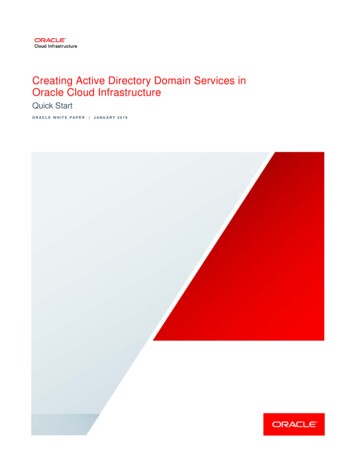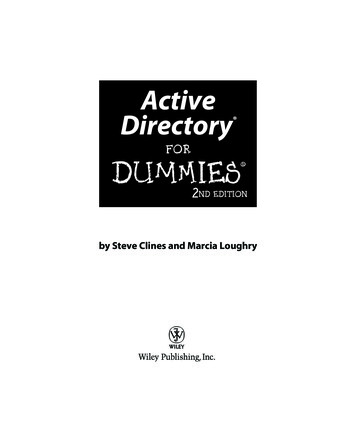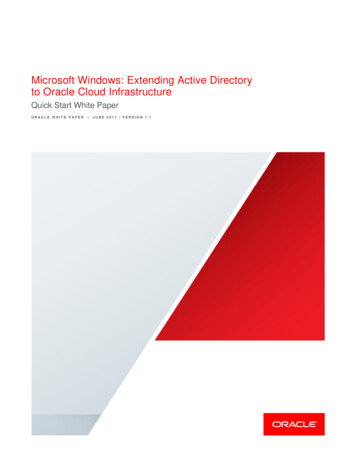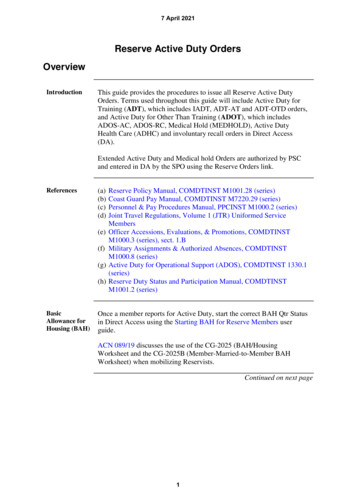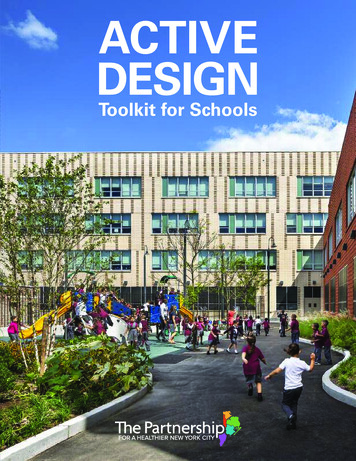
Transcription
ACTIVEDESIGNToolkit for Schools
We dream of a day when all students in New York Cityare physically activeand healthy.THE PARTNERSHIP FOR A HEALTHIER NEW YORK CITYThe Partnership for a Healthier New York City represents a multi-disciplinary group of peopleworking in education, public health, youth development, urban planning and transportation witha common goal of making New York City a healthier place for everyone. The Active Design Toolkitfor Schools represents the work of this Partnership with input from representatives of New YorkCity’s Departments of Health and Mental Hygiene, Education and Transportation. This toolkit wasinspired by conversations with New Yorkers who envisioned creative ways of implementing activedesign in our children’s schools. We hope you are inspired, by the stories presented and theideas and resources provided, to promote physical activity and healthy eating in our schoolsand beyond.For more information about The Partnership for a Healthier New York City, visit healthiernyc.orgFront Cover: The Settlement Housing Fund, the New York City Department of Education, and the School Construction Authority partnered todevelop the New Settlement Community Campus in the Bronx. Designed by Dattner Architects and Edelman Sultan Knox Wood Architects,the new mixed-use campus with two schools and a community center serves over 1,000 pre-kindergarten to 12th graders, and the localcommunity.Credit: Esto Photography Courtesy of NYC School Construction Authority
ACTIVE DESIGN Toolkit for SchoolsCONTENTSINTRODUCTION2ACTIVE RECREATION41Outdoor Infrastructure Changes2Indoor Infrastructure Changes5103 Transforming School Spaces with Art164Utilizing Existing Spaces Creatively205Looking Beyond Your School24HEALTHY FOODS AND BEVERAGES281Making Infrastructure Changes292Revamping Food and Beverage Options343Promoting Healthy Foods and Beverages Throughout Your School36GREEN SPACES AND NATURE40GETTING TO AND FROM SCHOOL461Promoting Safe Commuting to School472Promoting Safe Biking523Beautifying the Streetscape58MAKING IT HAPPEN64APPENDICES68Appendix A: The Building and Visioning Community Workshop68Appendix B: Getting the Word Out74Appendix C: Active Design Checklists76Active Recreation76Healthy Foods and Beverages77Green Spaces and Nature78Getting To and From School79ACKNOWLEDGMENTS80REFERENCES82
ACTIVE DESIGNToolkit for SchoolsINTRODUCTIONACTIVE RECREATIONHEALTHY FOODS ANDBEVERAGESINTRODUCTIONActive design: An approach to the development and design of buildings,streets and neighborhoods that uses architecture and urban planning tomake daily physical activity and healthy foods and beverages more accessibleand appealing.CURRENT SCHOOL LANDSCAPEEvery child deserves a healthy, positive school environment. Children’s physical,emotional and social development all benefit from daily physical activity and healthyeating. Better fitness levels are also associated with better academic performance.1Currently, only 20% of New York City (NYC) high-school students are getting therecommended 60 minutes of daily physical activity2 and less than half (41.3%)participate in daily school physical education.3 Close to 40% of students inkindergarten through 12th grade in NYC are overweight or obese,1 puttingthem at greater risk for chronic diseases as they move into adulthood. Becausestudents spend so much of their day at school, schools are uniquely positionedto help increase physical activity and healthy eating opportunities for students.THE CHALLENGESThe spaces in and around our schools can influence whether or not children arephysically active. Many schools lack adequate play yards or gymnasiums. Someparents do not feel confident that their children can actively travel (i.e. walkor bike) to school safely. Also, some students express that litter near theirschools makes physical activity in those spaces unappealing.STEPS TOWARD A SOLUTIONThere are many creative ways, both large and small, to foster physical activity inand around schools. You—as a part of the school community—can help re-designspaces in and around your school to encourage physical activity and healthyeating as a part of daily life. This toolkit provides ideas and resources to incorporateactive design into your school. Many of the ideas presented are simple, but haveimmense potential to improve the overall success, health and well-being of ourCity’s students.2The Partnership for a Healthier New York City
GREEN SPACES ANDNATUREGETTING TO AND ENCESMAKING IT HAPPENBenefits of PhysicalActivity 4,5MORE FOCUSOn School TasksMOREATTENTIVENESSIn the School SettingLOWER LEVELSOf Anxiety and y FitnessSTRONGERMusclesLOWER RISKOf Developing ChronicDiseasesGREATER CHANCEAt a Healthier AdulthoodKids get moving outside with Asphalt Green’s Recess Enhancement Program.Credit: The Partnership for a Healthier New York CityI dream of a day when.all schools involve students as leaders in the built environment.MAC, MANHATTANVisit nyc.gov and search “active design”3
ACTIVE DESIGNToolkit for SchoolsINTRODUCTIONACTIVE RECREATIONHEALTHY FOODS ANDBEVERAGESACTIVE RECREATIONActive recreation: structured or unstructured play, leisure activitiesor exercise.Many schools across NYC have inadequate outdoor space for play, sportsor exercise for students. The challenge of inadequate recreational facilitiesdisproportionately impacts schools in Black and Latino communities.6 Yet,increasingly, NYC schools are developing creative solutions to provide spacefor play, sports or exercise. Your school community can create solutions too.WHY THIS MATTERS Physical activity has both immediate and long-term benefits for academicperformance.7 Unstructured playtime promotes creativity and strengthens problemsolving skills.8 Physical activity helps children develop social skills.9 Active recreation can promote self-esteem.9 Organized recess activities may help reduce bullying.10The NYC Department of Education (DOE) Office of School Wellness offersmany resources to schools looking to implement active design strategiessuch as small grants, an informational portal and guidance for creating aSchool Wellness Council.Visit schools.nyc.gov, search “Office of School Wellness”I dream of a day when.all schools combine education and play to create a new dynamicway of learning.SHARIFA, QUEENS4The Partnership for a Healthier New York City
GREEN SPACES ANDNATURE1GETTING TO AND FROMSCHOOLMAKING IT SOUTDOOR INFRASTRUCTURE CHANGESChanges large and small to a school’s built environment can transformstudents’ ability to play outside.Ideas:Pursue a joint use agreement to open school playgrounds for after-hours use.Keeping school playgrounds open after hours gives more youth and communitymembers access to play and exercise spaces when the school day is done.Paint or stencil on concrete or asphalt lots or yards. Painting hopscotch andother games on the ground is a cheap and easy way to increase children’s activitylevels.11Build a buddy bench. Schools across the country are using brightly coloreddesignated “buddy benches” on the playground to promote kindness and counterbullying. A student can sit on a buddy bench if he or she feels lonely. Other studentsare encouraged to approach anyone on the buddy bench and invite him or her to play.Consider roof space. Roof space may present an opportunity for schools withoutstreet-level space to build facilities such as a track or to plant a garden.Open a Play Street near your school building. Play Streets offers permitsto create a car-free block during specified hours so students can enjoy outdooractivities throughout the school year. Play Streets can provide space for recessor for physical education.Questions to Consider1. Are children active in outdoor school areas?2. How do the outdoor spaces look and feel?3. Do the outdoor spaces support appropriate activities for the age group(s)being served?Visit nyc.gov and search “active design”5
ACTIVE DESIGNToolkit for SchoolsINTRODUCTIONACTIVE RECREATIONHEALTHY FOODS ANDBEVERAGESResources:Changelab Solutions has useful resources on implementing joint use or shareduse agreements.Visit changelabsolutions.org/shared-useKaBOOM! provides grants and other resources to communities interested increating and enhancing play places. “Build it Yourself!” by applying for one ofKaBOOM!’s 15,000 grants or a chance to “Build it With KaBOOM!” Sign upfor grant alerts at KaBOOM!’s website.Visit kaboom.orgNYC Guide for Green Roofs on Existing School Buildings explains thebenefits of green roofs and provides guidance on cost and maintenance.Visit F595ABD8646B3E/0/GreenRoofGuidance.pdfIn a Bedford-Stuyvesant housingdevelopment, over 200 volunteerscame together to build this childdesigned playground with KaBOOM!,Forest City Ratner, and BedfordStuyvesant Restoration Corporation.Improvements like this can be madeat schools.Credit: The Partnership for a HealthierNew York CityPeaceful Playgrounds sells low-cost, easy-to-apply school playground stencilsfor ground markings you can paint to create active play spaces for students.Grants for other school improvement projects are also available.Visit peacefulplaygrounds.comSchool Play Streets can be operated daily to weekly by schools or by communityorganizations. Public and private schools in all five boroughs are eligible to apply.Work with your community board to obtain approval to organize a Play Street.Visit nyc.gov, search “play streets” or email playstreets@health.nyc.govThe Trust for Public Land NYC works closely with public school students, staffand community members to design and renovate new playgrounds on barrenasphalt lots. These projects include athletic fields, basketball courts, runningtracks, gardens, seating, trees and drinking fountains. Find out about the new“Green Playgrounds” being built in partnership with the NYC Department ofEnvironmental Protection (DEP) and the DOE.Visit tpl.org/nycplaygroundsDID YOU KNOW?Getting students involved in school transformations may help improve schoolconnectedness. Better school connectedness can mean:12 Better grades Lower smoking rates Less violence6The Partnership for a Healthier New York City
GREEN SPACES ANDNATUREGETTING TO AND FROMSCHOOLMAKING IT SWith design input from students and nearby residents, the NYC Department of Environmental Protection, NYC Department of Education, andthe Trust for Public Land in partnership with public and private sectors created this new playground at J.H.S. 218 in East New York. It is designedto absorb storm water runoff and prevent flooding while providing access to play and recreation for students and the surrounding community.Credit: The Trust for Public LandVisit nyc.gov and search “active design”7
Success Story 1: Transforming an Asphalt Yard into aBeloved Sports ParkLocation: P.S. 87, Wakefield, BronxGoalTo increase recreation and play space for the school and communityKey Takeaways Create private and public partnerships Engage students, staff and the community from the beginningP.S. 87 has long been a center of physical activity in the Wakefield community ofthe Bronx. In addition to the school’s strong emphasis on recreation and athletics,the Bronx Flash Track Club, a division of the New York Road Runners, ran an afterschool and summer program at the school. Unfortunately, what the school possessedin enthusiasm for its sports and recreation programs, it lacked in physical spaceto play. The play yard was a cracked asphalt lot divided by chain link fences, and theclosest park was located more than a mile away.In 2010, that changed. P.S. 87 students and staff along with community sponsorUnity Neighborhood Center partnered with the New York City Department of Parksand Recreation (NYC Parks and Recreation), PlaNYC, The Trust for Public Land andthe Arlene & Arnold Goldstein Foundation to transform the school’s empty yardinto a vibrant park.The new space is open to the community after school hours and on weekends,year-round. It features a turf soccer field, a running track, basketball hoops, playequipment, outdoor spaces where classes can be held, a stage, a water fountain,benches, game tables, raised garden beds and trees. One school staff memberremarked how the park is the centerpiece of the school and that it has generateda lot of enthusiasm in the school and community. Now the neighborhood soccerteam has a new field to use and student athletes have a place to practice skillslike teamwork and self-discipline that transfer to the classroom.Top: Before, the outdoor space at P.S. 87was nearly unusable.Bottom: Afterwards, with help fromthe Trust for Public Land, among others,the play area is vibrant with physicalactivity. Trees and bright paint givethe kids a reason to enjoy recess andother activities.Credit: The Trust for Public Land8This project was a team effort by a mix of private and public entities. The Trustfor Public Land led a participatory design process and secured approvals from theNYC School Construction Authority. The NYC Parks and Recreation provided fundsto construct the playground. The community sponsor, Unity Neighborhood Center,led community organizing and outreach efforts.Most importantly, students, staff, parents and the broader community wereinvolved in the design process from the beginning. Incorporating the people whounderstand the needs of the community best, and who will use the equipmentand space most, took time, but it ensured that the project was a success.The Partnership for a Healthier New York City
Children enjoy the track on their newplayground.Credit: The Trust for Public Land
ACTIVE DESIGNToolkit for SchoolsINTRODUCTIONACTIVE RECREATIONHEALTHY FOODS ANDBEVERAGESActive buildings: Buildings that encourage physical activity by supportingactive transportation, active recreation, exposure to green space and nature,and access to healthy food and beverages.2Key Questions toConsider1. Does the school buildinghave a gym?2. If so, does the schoolmaximize the space?3. Does the building haveany unused classrooms?4. Are there other, non-traditional spaces in the schoolthat can be used to promotephysical activity?INDOOR INFRASTRUCTURE CHANGESHave unused space? Or have a vision for transforming a space? Manyschools have used the following ideas and resources to increase students’physical activity.Ideas:Install “springy gym flooring” in a non-traditional space. Install a gym floor, safefor physical activity, in spaces such as the school lobby, cafeterias or even hallwaysand classrooms so that those spaces can serve multiple purposes.Build an indoor playground. This requires some creativity and planning.Go to page 14 to read the story of how The Renaissance Charter School inJackson Heights, Queens built an indoor play space, and get inspired!Convert unused or underused spaces into a fitness space. When thinkingthrough alternative spaces to a gymnasium, consider unused classrooms, thelobby, the auditorium and hallways. Ask students what they would like to see ina fitness room. Hula hoops? Weights? Climbing walls? Other equipment?Coordinate the use of spaces. Multiple schools can be co-located in the samebuilding. To maximize the use of space and minimize conflicts, be sure to assignone person or system to schedule usage for all schools in the building.In Manhattan, P.S. 110’s lobby doublesas a gym space after the concretefloor was replaced with an “Elastiwood”surface suitable for physical activity.Credit: NYCDOHMH10The Partnership for a Healthier New York City
GREEN SPACES ANDNATUREGETTING TO AND FROMSCHOOLMAKING IT SDID YOU KNOW?There is emerging evidence that classroom and furniture design may influence incidental physical activity in children.For example, having movable furniture and enough space in classrooms for children’s movement, as well as furniturethat increases micro-movement rather than static sitting, may help increase children’s physical activity levels.13,14,15,16,17Furniture can encourage an active postureand special seating can be designed tosupport children’s micro-movement.Credit: VMDO ArchitectsVisit nyc.gov and search “active design”11
ACTIVE DESIGNToolkit for SchoolsINTRODUCTIONACTIVE RECREATIONHEALTHY FOODS ANDBEVERAGESResources:DID YOU KNOW?The Office of the UnitedNations High Commissionerfor Human Rights recognizesplay as a child’s human right.18DOE’s Office of Space Planning works with the DOE Office of School WellnessPrograms (OSWP) and New York City School Construction Authority (SCA) to supportschools that are struggling with space constraints. In two years, the office completed30 renovations, including the creation of fitness rooms and space conversions topromote physical activity.Visit schools.nyc.gov, search “Office of Space Planning”Architecture for Humanity believes that everyone deserves access to the benefitsof good design. Through Design Education for Youth, they work with local youthto design and develop innovative educational spaces that encourage learning andfoster pride in the community. The organization helps clients realize their goalsthrough various methods, including design charrettes (design or planning activities),competitions, schematic and design services, education and advocacy, and smallscale design/build services.Visit afhny.orgCenter for Architecture Foundation promotes public understanding and appreciationof architecture and design through educational programs for kindergarten through12th grade students and teachers, families, and the general public. Their programsuse the built environment and visual tools to inspire participants to think criticallyabout the importance of design in the world around them.Visit cfafoundation.orgM.S. 223 in Mott Haven turned theirstaff lunchroom into a fitness center.The new space is open to students,staff and parents.Credit: M.S. 22312The Partnership for a Healthier New York City
GREEN SPACES ANDNATUREGETTING TO AND FROMSCHOOLMAKING IT SP.S. 47 in Manhattan requested Resolution “A” funds to create this playground. Reso “A” projects are school specific and the individual grants go towardsenhancements and upgrades to existing facilities.Credit: NYC School Construction AuthorityFunding TipYou can request funding for large-scale improvement projects throughcapital funding or Resolution “A” funding requests to the City Councilor Borough President’s Office.See the “Making it Happen” section for more information.Visit nyc.gov and search “active design”13
Success Story 2: Soliciting Community InvolvementLocation: The Renaissance Charter School, Jackson Heights, QueensGoalsTo design an indoor playground through collaboration and get studentsactive indoorsKey Takeaways When outdoor space is limited, explore creative uses of indoor space Always solicit ideas and input from students Build relationships with local community leaders and encourage theirparticipation in projectsThe Renaissance Charter School in Jackson Heights, Queens was created outof a collective endeavor among teachers, parents, architects and designersto convert an old department store into a school. When educators faced thechallenge of limited outdoor space for recess, they were inspired to design aspace with the creative vision of the school community.The school community decided to install a playground in a common indoor space.School leaders asked students to think of their ideal playground design. Submissionswere considered based on the space constraints and whether they were feasible.The students expressed a love for bridges and color, so these elements wereultimately included in the new play space. Teachers’, custodians’, parents’ and evengrandparents’ ideas were included in the planning process.To make the school community’s dreams a reality, while considering safety andpracticality, the school consulted with the NYC School Construction Authority (SCA),DOE Offices of School Planning (Division of District Planning) and Building Design,and the school’s custodial office. A private playground designer and local artistsalso offered support.Just like Central Park, the indoorplayground features tunnels andbridges. The walls beyond arepainted to represent CentralPark’s greenery.Credit: Renaissance Charter School14Thanks to committed and vocal parents and the school’s strong relationshipswith local elected officials, the funding and other capital resources needed forthis project were secured.The school now has a playground that resembles Central Park—with “running paths”painted on the ground and trees, rocks and statues painted on the walls! The playgroundalso incorporates bridges and plenty of color. Today, the playground is used for recesstwice daily and for after-school programs.The Partnership for a Healthier New York City
Students helped to design thecommon space for early grades atThe Renaissance Charter Schoolin Jackson Heights, Queens.Credit: NYCDOHMH
ACTIVE DESIGNToolkit for SchoolsINTRODUCTION3ACTIVE RECREATIONHEALTHY FOODS ANDBEVERAGESTRANSFORMING SCHOOL SPACES WITH ARTArt can help draw attention to messages of health and well-being—bothoutdoors and indoors. It can also promote physical activity by makingspaces more pleasant and inviting.Ideas:Use creative messaging and brighten up the stairwells. Signs and artworkencouraging people to take the stairs have been shown to be effective. Whilestudents are required to take the stairs at most NYC schools, the stairwells canalso be used as a place to reinforce messages of healthy living. Consider askingstudents to paint a mural on the stairwell walls or on the stairs themselves.Decorate wall space and old handball courts. Work with your school communityto redesign these spaces using paint, photography and more!Give old basketball hoops and courts a facelift. Keep the correct court markingsand have students redesign the backboards, or add a fresh coat of paint to courts.Decorate the fence. You can lighten up the fence around the playground for studentsand passersby using cups, ribbon, yarn, or even photography and painting.Top: Students at work stenciling theirstairwell in homage to Keith Haringand active living.Credit: The Partnership for a HealthierNew York CityBottom: A mural outside of a Harlemschool created in partnership withCityArts, an organization that bringsyouth and artists together.Credit: The Partnership for a HealthierNew York CityI dream of a day when.all students explore creativity as a daily experience, to dream, toexperiment, to love each day.DONALD, MANHATTAN16The Partnership for a Healthier New York City
GREEN SPACES ANDNATUREGETTING TO AND FROMSCHOOLMAKING IT SResources:Groundswell brings together artists, youth and community organizations to visuallytransform public spaces.Visit groundswellmural.orgHabitat for Humanity NYC’s Brush with Kindness program can help your schoolbeautify and rehabilitate the playground area through mural painting.Visit habitatnyc.orgMaterials for the Arts (MFTA) distributes free materials to teachers for use inthe classroom. MFTA, NYC’s premier creative reuse center, is a unit of the NYCDepartment of Cultural Affairs, with support from the NYC Departments of Sanitationand DOE. MFTA collects a wide variety of materials donated by businesses andindividuals and makes them available for free to non-profit organizations with artsprograms, public schools, and NYC government agencies. All public school teachers,not just art teachers, can register for membership with Materials for the Arts toreceive free classroom supplies.Visit nyc.gov/mfta or call 718-729-2150NYC Department of Transportation (DOT) partners with community organizationsand artists to showcase art. If your school is near DOT property, contact the DOTto see if that space is eligible for its art program.Visit nyc.gov/dotartNYC Stair Prompts promote stair use and can be ordered for free by calling 311.Visit nyc.gov, search “stair prompt”Public Art for Public Schools, a unit within the School Construction Authority,commissions art projects for new schools, maintains and preserves artworkin existing schools, and oversees art donated to NYC public schools.Visit nycsca.org, search “public art”PubliColor works with at-risk students to build self-confidence through designand painting-based programs. Students transform their own schools and nearbycommunity facilities with vibrant colors.Visit publicolor.orgXmental, Inc is a coalition of community organizers, artists and teachers committedto mentoring and educating urban youth. Xmental works with youth on graffiti projectsto beautify spaces.Visit xmental.orgVisit nyc.gov and search “active design”17
Success Story 3: Transforming a Dilapidated Playgroundthrough Teamwork and ArtLocation: 220 Henry Street, Playground, Lower East Side, ManhattanGoalTo brighten up an outdoor play space and to encourage physical activityKey Takeaways Small changes can yield big improvements When assessing your space, think about shared-use Work together with local stakeholders to maximize successIn 2014, District 1 Community Education Council (CEC1), The Partnership for a HealthierManhattan, Xmental, Inc. and four co-located Lower East Side schools (UniversityNeighborhood Middle School, CASTLE Middle School, Henry Street School forInternational Studies and Manhattan Charter School) celebrated the completion ofa mural and fence art installation at their shared playground at 220 Henry Street.The mural represents the collaboration between four District 1 schools to promotehealthy and active living.Some cans of spray paint waiting tobe used to beautify the playground inpartnership with Xmental.Credit: The Partnership for a HealthierManhattanThis project began after a districtwide needs assessment of school gym and playyard facilities showed that this playground, which was shared by several schools,was in need of a makeover. In response, the CEC1 and their District LeadershipTeam hosted an active design workshop about enhancing the environment tohelp promote healthy lifestyles. After attending the workshop, the participatingschools were inspired to beautify the 220 Henry Street playground, recognizingthe potential impact on the health and academic achievement of their students.The schools partnered with Xmental Inc, a non-profit that mentors youth throughthe power of art. Xmental Inc. worked with students and community members toreimagine the play space and take it from design to implementation. They armedthemselves with paint rollers and spray cans to create a mural paying homage toNYC underground graffiti artist pioneer Lee Quiñones, who first painted the handballcourt in the playground in the 1970s. By participating in this process, students fromthese four schools will leave, as their legacy, an enlivened school yard that studentswill enjoy for years to come.Each school contributed to transform a once dilapidated and grey space into an areathat fosters well-being. The mural promotes health and active living, not just for thefour schools it serves, but for the entire Lower East Side community.18The Partnership for a Healthier New York City
Students at four schools on the LowerEast Side partnered with Xmental, Inc. tobring active design to their playground.Credit: The Partnership for a HealthierManhattan
ACTIVE DESIGNToolkit for SchoolsINTRODUCTION4ACTIVE RECREATIONHEALTHY FOODS ANDBEVERAGESUTILIZING EXISTING SPACES CREATIVELYUse programming to complement infrastructure changes to get studentsmoving. Partner with program providers to creatively make use of limitedspace.Ideas:Connect with an outside organization to offer training to teachers or to runprogramming.Participants of Asphalt Green’s RecessEnhancement Program have a blastoutside.Credit: Asphalt GreenUse existing spaces such as auditoriums, hallways and even the classroom forphysical activity programming.Use video and audio programming to help get students moving indoors.Resources:Activity Works is a series of curriculum-aligned classroom-based physical activityaudios and video designed for pre-K through third grade.Visit activityworks.comAsphalt Green’s Recess Enhancement Program (REP) offers training andprofessional development to help elementary schools address barriers to physicalactivity during recess such as lack of adequate play space and staffing. REP alsobrings recess indoors by modifying recess activities for the auditorium, cafeteria,classroom, gym and hallway.Visit asphaltgreen.org/REP or email rep@asphaltgreen.orgThe DOE Office of School Wellness Programs has many helpful resourcesfor schools.– Training in workshops such as “No Gym? No Problem!” or certification in the“Physical Best: Physical Education for Lifelong Fitness” curriculum are amongthe many resources for professional development.Visit schools.nyc.gov– School Wellness Works Portal includes a database of resources for physicaleducation, health education, physical activity, food, school environment andcommunity wellness. Email Wellness@schools.nyc.gov with “Portal” in thesubject line for access. Program staff will contact you with instructions.– Move-to-Improve (MTI) trains kindergarten through fifth-grade teachers toincorporate short, structured activities that integrate physical activity intoeducational lessons and are aligned with New York State Physical Education(PE) Learning Standards. MTI can supplement a school’s existing PE programand help schools meet the required 120 minutes of PE per week. Also, MTIactivities integrate new Common Core Learning Standards.Visit schools.nyc.gov, search “move to improve”20The Partnership for a Healthier New York City
GREEN SPACES ANDNATUREG
street-level space to build facilities such as a track or to plant a garden. Open a Play Street near your school building.Play Streets offers permits to create a car-free block during specified hours so students can enjoy outdoor activities throughout the school year. Play Streets can provide space for recess or for physical education.

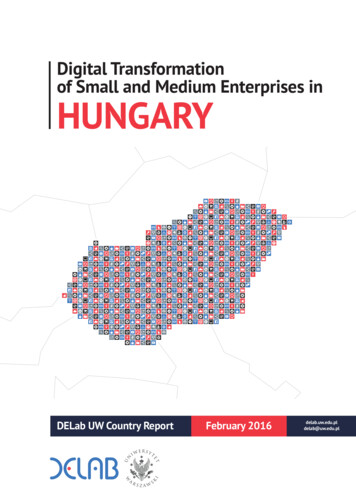
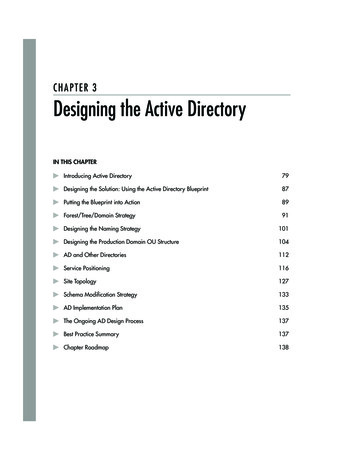
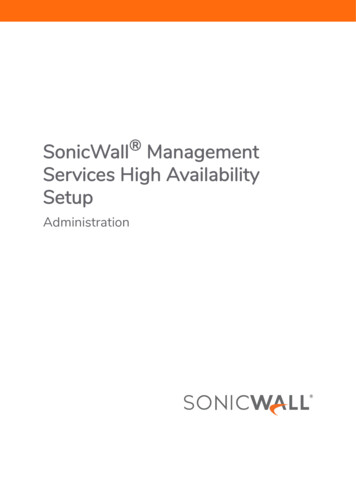
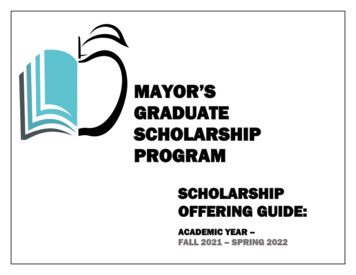
![[MS-ADFSOD]: Active Directory Federation Services (AD FS .](/img/1/5bms-adfsod-5d.jpg)
